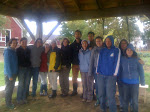 |
| the last trays in the cold frame |
 |
| Nora carrying kale. |
This morning, I joined the group putting the first plants in the ground. This is the field we watched being plowed yesterday--Middle Field in North Orange. First we loaded all the plants into the trucks, as well as a soil amendment, hand tools, buckets and water. Then we drove over the the field and unloaded everything.
 |
| Rebekah carrying chard |
 |
| The truck, filled and ready to go |
 |
| Nitrogen rich amendment for the soil |
 |
| Kiyoshi hoeing in the 8-1-1 |
We spread the 8-1-1 amendment on the field to give the soil a healthy dose of nitrogen and hoed it in. Then the tractor went over each bed sketching in three rows on each bed.
To plant our vegetable starts, we first dipped the trays in a diluted fish emulsion. It smelled a lot like the boathouse at Stoney Point on Great Spirit Lake (family reference) without the gasoline smell. Then one of partner a pair placed each plug about a foot apart along the bed and the second of the set dug a hole with a trowel and placed the plug in the ground. We did this for our different kinds of kale and then our collard greens.
Lastly we planted several rows of Swiss Chard. The variety we use is called "Bright lights" and we harvested it last fall in "bouquets" since the stems are of such different colors: white, fuschia, yellow, orange and red. As we placed the plugs, sometimes there was more than one germinated plant. We got to choose one and pluck the spare and one factor in choosing was to make sure there was a variety of stem colors.
 |
| Chard in the ground! |
 |
| Drilling through wood and steel |
 |
| Carriage bolts in a line |
In the afternoon, I worked on the new wood wagon. You may have seen the old manure spreader being demolished several weeks ago. Then people have been welding the wheel axles of that spreader to a new frame. Today the wood planks were being attached to the frame. First the boards were cut to length. Next a drill with a very strong bit bored through the wood and then the steel. Last, for today, we used carriage bolts with washers and nuts underneath. We did this during a rainstorm and it was a bit wet slithering under the wagon to tighten the nuts. Even though I had a tarp, I kept sliding off it and ended up with a very wet back. The plan is to put removable sides on the wagon--in the summer, we use it as a flat bed to move harvested vegetables out of the field and in the winter, put the sides on and carry firewood to Maggie!










No comments:
Post a Comment